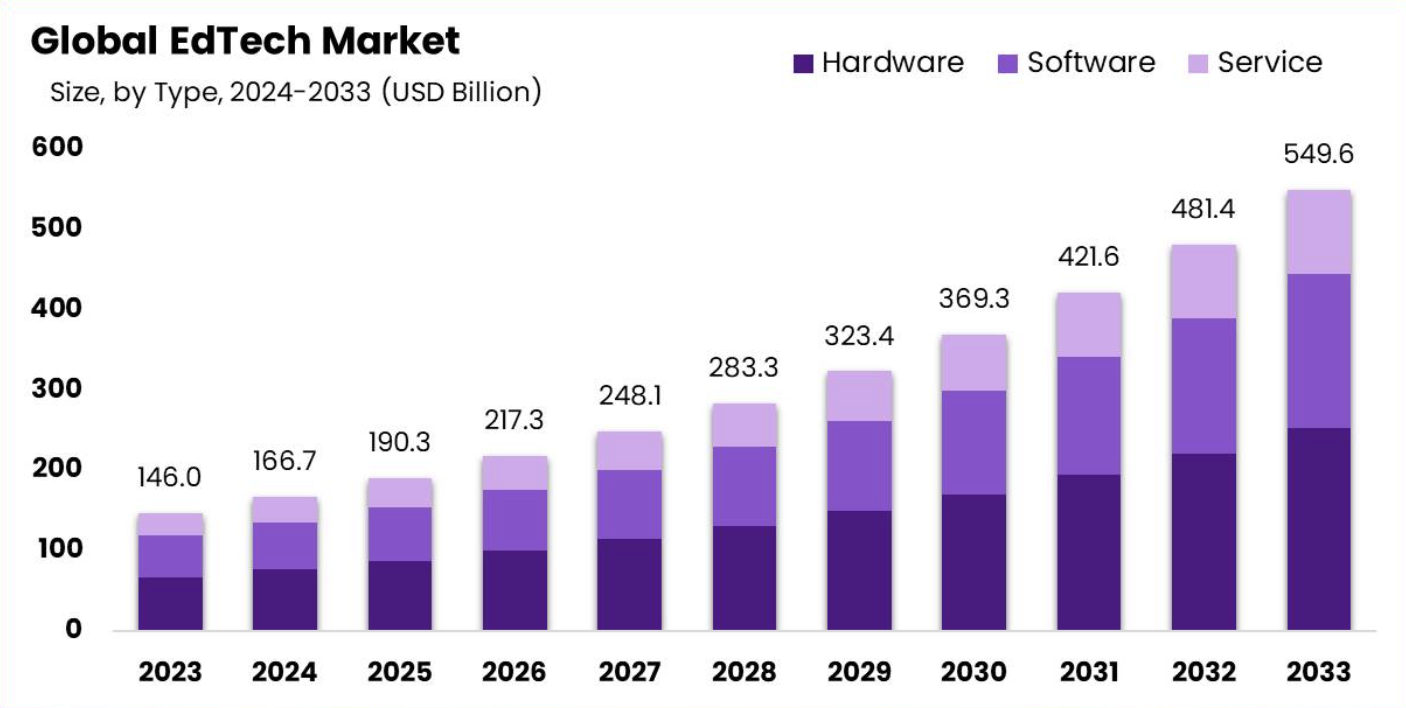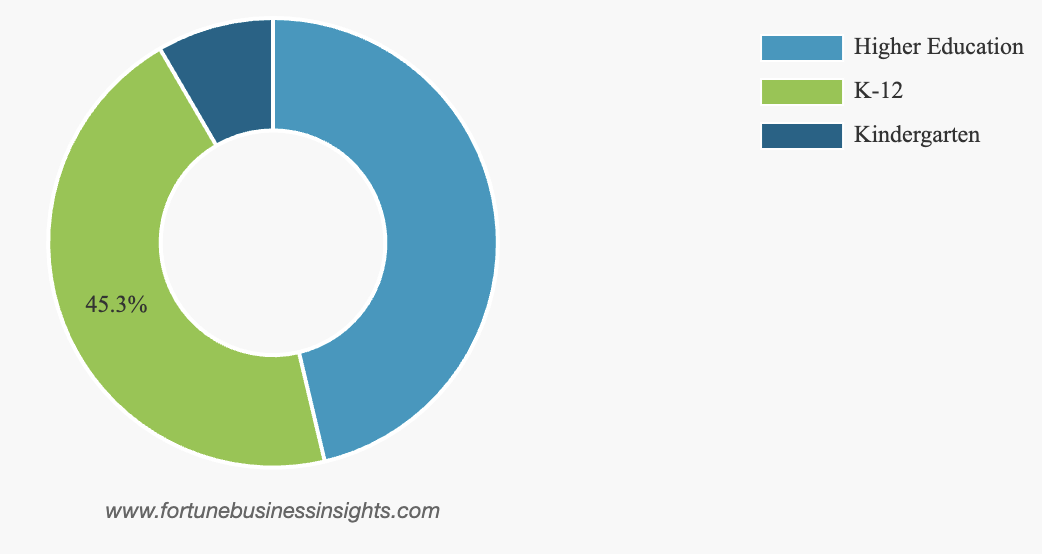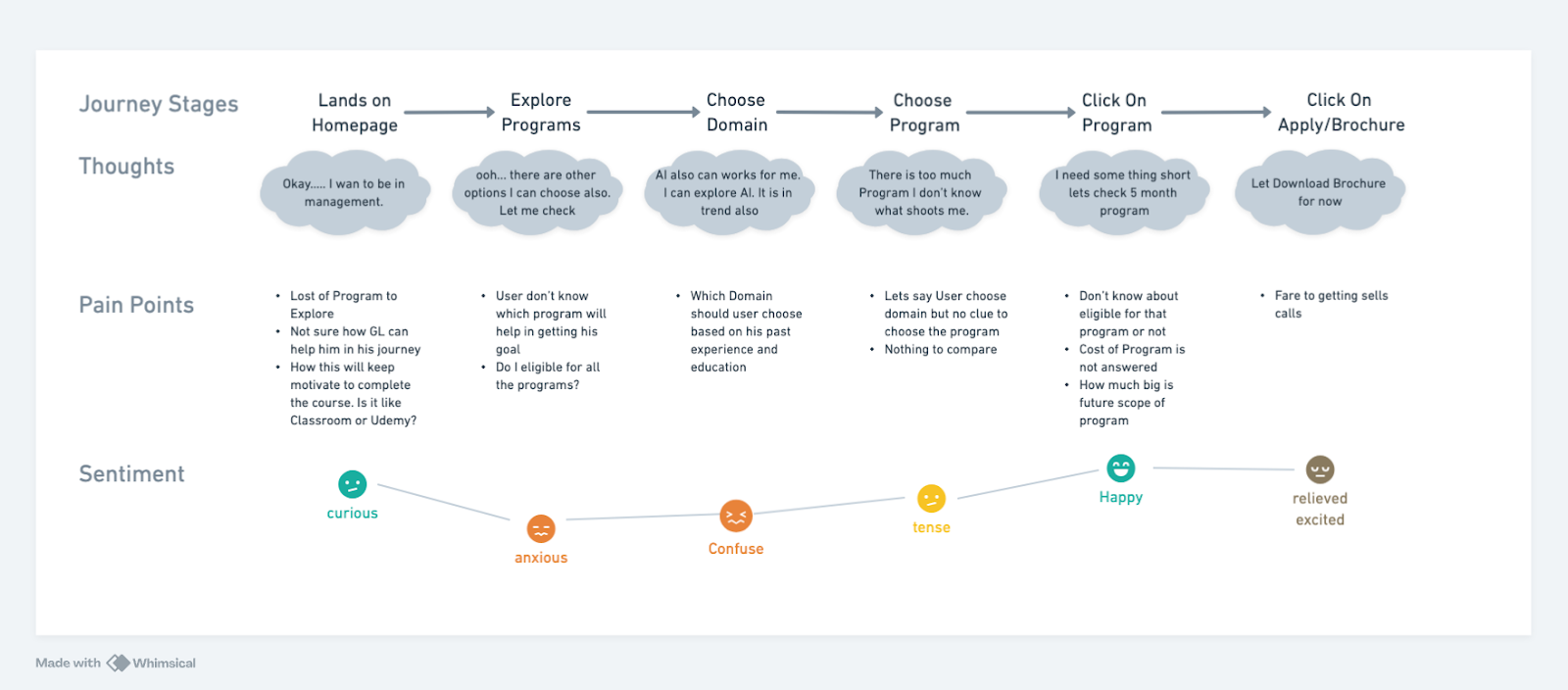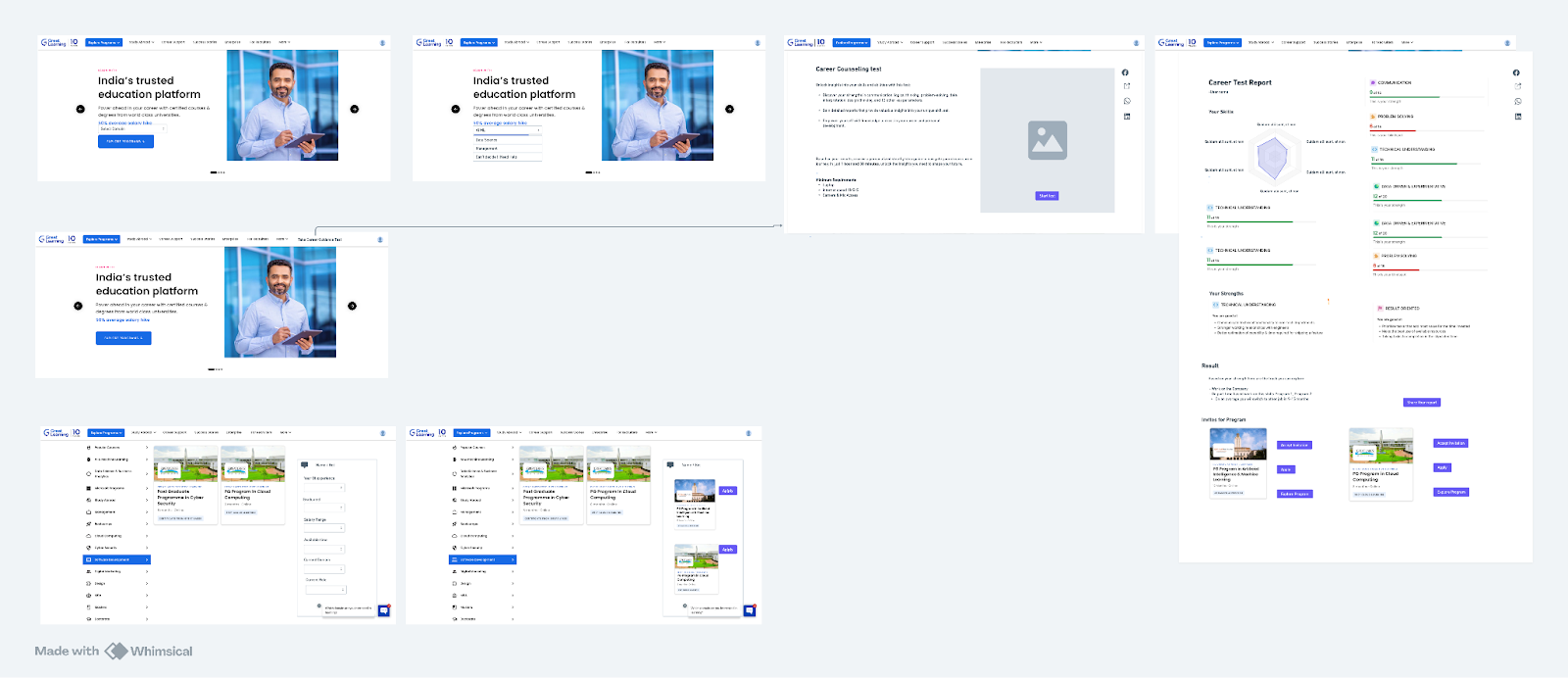Career Clarity Tool
Problem Statement
Ideation and Development of a Viral Ed-Tech Feature for Great Learning Academy
Context
As the product owner of Great Learning Academy, a free course platform, your task is to
conceptualize, justify, and outline the development of a feature or product that leverages the
platform's free ed-tech offerings. This feature should aim to create virality and build a
self-generating top funnel to attract more monetizable users. The primary problem to solve is
creating a sustainable top-funnel strategy. This strategy should draw users to the platform and encourage them to engage with the content in a way that naturally leads to an interest in paid offerings. This assignment focuses on developing a unique, viral feature that leverages either existing course assets or creating new edutainment/edtech assets. This feature should serve as a catalyst for word-of-mouth marketing, thereby creating a self-perpetuating cycle of user acquisition and conversion.
About Company
Great Learning is a prominent company in the educational technology (ed-tech) field, focusing on professional and higher education. It offer a variety of programs, including degrees, certificates, and live online courses, in domains like data science, business analytics, management, and technology. Collaborations with prestigious academic institutions like Stanford University, MIT, and several Indian Institutes of Technology (IITs) further strengthen their course offerings
- Mission: To bridge the gap between industry requirements and professional skillsets by providing industry-oriented programs.
- Vision: To be a leading global company in professional and higher education, making impactful learning accessible to everyone.
Market Research

The Global EdTech market is projected significant growth, with the market value expected to reach around USD 549.6 billion by 2033, up from USD 146.0 billion in 2023, representing a CAGR of 14.2%. The hardware segment, including interactive displays, tablets, and laptops, is expected to contribute around 60% of the revenue in 2023, driven by the increasing adoption of technology-driven teaching methods globally. In the EdTech market, the K-12 sector dominates with a market share of 45.3% in 2023, highlighting the increasing use of digital tools and interactive learning platforms in primary and secondary education.The higher education segment currently holds a market share of around 42.5%.

The market leaders in the Indian EdTech industry include Coursera Inc., BYJU’S, Chegg Inc., 2U Inc., Amazon Inc., Blackboard Inc., Edutech, Google LLC, edX Inc., Instructure, Inc., Udacity, Inc., upGrad Education Private Limited, and other key players.
Source: market.us , fortunebusinessinsights,
Current Trends in Ed-Tech:
- Personalised Learning: Individualized learning paths tailored to each student's strengths, weaknesses, and preferences.
- Online Collaboration: Tools and platforms that facilitate collaboration among students and instructors in a virtual environment.
- AI and Machine Learning: Use of AI to personalise learning, automate administrative tasks, and provide insights into student performance.
- Microlearning: Bite-sized learning modules that are easy to consume and fit into busy schedules.
- Gamification: Integration of game elements such as points, badges, and leaderboards to enhance engagement and motivation.
- AR and VR: Immersive technologies that provide interactive learning experiences, particularly useful for subjects that require visualisation.
- Mobile Learning: Increased use of mobile devices for learning, enabling access to educational content anytime, anywhere.
- Lifelong Learning: Focus on continuous learning beyond traditional education, driven by the need to upskill or reskill in a rapidly changing job market
Competitors
Direct Competitors - Offering Similar Programs:
- UpGrad: A major competitor in India, offering online programs in similar fields like data science, management, and technology.
- Simplilearn: also known for its vast library of online courses across various disciplines.
- Udemy: A global platform with a wide range of affordable online courses, including some that might overlap with Great Learning's offerings.
Indirect Competitors - Catering to Different Segments:
- Coursera and edX: Offer online courses from prestigious universities, potentially competing for learners seeking traditional degrees or credentials.
- DataCamp and Dataquest: Focus specifically on data science education, which might be a niche Great Learning is targeting.
User Segment
- Working Professionals: This segment includes individuals who are currently employed and are looking to enhance their skills or learn new ones to advance in their careers or transition to new roles or industries.
- Students: Great Learning also attracts students who are pursuing higher education or are in the early stages of their careers and are looking to supplement their formal education with practical skills and knowledge.
- Career Changers: Some users may be looking to switch careers and are using Great Learning to acquire the skills and knowledge needed for their new career path.
- Entrepreneurs and Business Owners: Individuals who are running their own businesses or startups may also use Great Learning to acquire new skills or knowledge to help them succeed in their ventures.
- Lifelong Learners: These individuals who have a passion for learning and are constantly seeking to expand their knowledge and skills, regardless of their current career status.
User Persona
User Persona - I (Working Professional)
Name: Sarah
Age: 32
Occupation: Marketing Manager
Background:
Sarah has been working in the marketing field for the past seven years and has achieved success in her role. However, she feels that her current job has limited growth opportunities and is looking to transition into a new job that offers better prospects and a more challenging role.
Goals:
- Find a new job that offers career advancement and a higher salary.
- Transition into a role that aligns with her long-term career goals and interests.
- Improve her skills and knowledge to make herself more marketable to potential employers.
Challenges:
- Lack of clarity on the specific job role or industry she wants to transition into.
- Uncertainty about the necessary steps to take to make a successful career transition.
- Balancing her current job responsibilities with the time and effort needed to search for a new job and acquire new skills.
Needs:
- Career guidance and support to help her identify the right job opportunities.
- Resources and training programs to enhance her skills and make her more competitive in the job market.
- Networking opportunities to connect with professionals in her desired industry and gain insights into potential job roles.
Personality:
Sarah is ambitious, motivated, and eager to take on new challenges. She is also determined and willing to put in the effort required to achieve her career goals.
User Persona - II (Newly Graduate)
Name: Amit
Age: 24
Education: BTech in Mechanical Engineering
Background:
Amit recently graduated with a degree in Mechanical Engineering and has been actively seeking job opportunities for the past year. Despite trying in both campus placements and the open market, he has been unable to secure a job in his field. Now, he is looking to switch to a different domain that aligns with his studies and job experience, hoping that it will require less effort to transition.
Goals:
- Find a job in a domain that aligns with his Mechanical Engineering background.
- Transition into a new field with less effort, leveraging his existing skills and knowledge.
- Secure a stable job that offers growth opportunities and a fulfilling career path.
Challenges:
- Uncertainty about which domain to switch to, as he wants to align it with his existing education and job experience.
- Lack of clarity on the necessary steps to transition to a new domain and secure a job in that field.
- Balancing the need to find a job quickly with the desire to find a role that aligns with his long-term career goals.
Needs:
- Career guidance and counseling to help him identify potential domains that align with his background and interests.
- Skill development resources to acquire the necessary skills for the new domain.
- Job search support and resources to help him secure a job in the new domain.
Personality:
Amit is determined and focused on finding a job that aligns with his background and interests. He is willing to put in the effort required to make a successful career transition and is open to exploring new opportunities.
Current User Journey
The current user journey of a working professional looking to upgrade to a new job involves seeking better opportunities and a more fulfilling job profile. However, they may feel lost or unsure about the next steps in their career.

Pain Points and Frustration
- When users land on the homepage, they are unsure about the specific benefits they will gain from joining a course. For example, they may not know the number of students who easily secure international jobs or their first jobs after completing a program. This lack of clarity leads to user drop-offs.
- Additionally, many users lack confidence in selecting a program or domain from the wide range offered by Great Learning and its partners. The homepage lists all programs without proper guidance, further contributing to user drop-offs.
- Even for users who are motivated and clear about their career path, selecting a specific program can be challenging. They may struggle to compare multiple programs and make a decision, despite exploring various options.
Hypothesis
Many users come to GL platform seeking career advancement or better job opportunities. However, a significant portion of these users struggle to identify the programs or courses that align with their needs. This results in user drop-offs or getting user extensive sales calls resulting in the frustration of the users.
As a business, GL faces loss of revenue from users who are in the exploration phase of their career growth or considering changing domains. Additionally, GL is spending a significant amount of money on sales calls and executives to convert these users into paying customers.
Solution
Personalized Career Guidance Report
Users will receive a free personalized Career Guidance Report that breaks down competencies for all necessary skills. These skills include: Communication, Problem-Solving, Logical Thinking, Design Thinking, Data-Driven Approach, Growth Mindset, Technical Skills, Analytical Abilities, Verbal Proficiency, Reading Comprehension, Creativity, Decision Making etc.
To generate this report, users need to complete a personality and psychometric test. Additionally, they should provide information about their current career and their dream career.
The system will analyze all inputs and strengths provided by the user. Based on this information, it will offer a personalized step-by-step guide to excel in the recommended domain. Furthermore, the system will provide suggestions for career changes or improvements, along with 2-3 recommended courses or programs to support the user’s journey.
This solution will provide clarity to users regarding their career paths, allowing us to cater to those who are passively searching or exploring options. When users gain clarity on their career direction and have confidence in the results provided by Great Learning, they are more likely to enrol in programs. This will increase revenue for Great Learning and decrease the costs associated with sales call support.
User Journey
There we can have 5 User journey
Discovery Dilemma
Users in this journey are exploring different domains and programs but are unable to decide on a specific one.
- Explore Mode: Users are in the exploration phase, browsing through various options to understand what suits them best.
- Lands on the home page
- Clicks on Explore Programs
- Clicks on Domain( Program type )
- Clicks on View All/ Program
- Land on the Program Details Page
- Popups appare after 5s of cursor move for testing test and decide easily
- Click on Give test
- Test Portal Appare
- Complete Test
- Give the top 2 Program recommendations and 3 Suggestions
- Test Mode: Users take a psychometric test to assess their skills and personality, aiming to gain clarity on their career path.
- In the Landing page user can see a list of Domains
- The last option should be “ Can’t Decide! We will help you.“
- Click on Give test
- Test Portal Appare
- Complete Test
- Give the top 2 Program recommendations and 3 Suggestions
Domain Clarity
Users are clear about the domain they want to enter but are searching for the right program within that domain.
- In the Landing user can see a list of Domains
- User Select Domain
- Lands on Domain-Specific Program List page
- Encourage users to share details such as their current job, educational background, future career goals, and salary expectations
- Give one recommendation and two suggestions based on the information
Program Precision
Users know the program they want to pursue but are looking for validation or more details before committing.
- Lands on HomePage/Landing Page
- Choose Domain
- Choose Program
- Try Now or Download the Brochure
Testing Waters
Users want to take a test to gauge their skills and receive recommendations for potential career paths.
- Lands on HomePage/Landing Page
- Click on “Take Career Guidance Test”
- Test Portal Appare
- Complete Test
- Give the top 2 Program recommendations and 3 Suggestions
Wireframe

Minimum viable product (MVP)
For the MVP, we will integrate with a third-party personality test platform and collect user history details on our platform. The analytical and recommendation aspects will be handled manually and the report will be sent via email. Initially, we will limit access to a select few users, possibly specific locations. If we observe a high conversion rate, we can proceed to develop the entire system.
Release Roadmap
| PHASE | FEATURE DEVELOPMENT | PURPOSE |
|---|---|---|
| MVP | Manual Operation | Checking Feature Acceptance |
| Beta Testing | Automate Manual effort | Checking Feature can produce results as promised |
| Phase One | Adding Feedback and asking about their Plan | Checking Do Feature is aligned with the User Career Plan |
| Phase Two | Add these features to all the user flows | integration with all GL User flows |
Resource Requirements
Technology Requirements
- Frontend Tech: React, Angular, Vue
- Backend Tech: Flux, Ruby on Rails, NodeJS, GO etc
- Machine Learning Team and Tools for Psychologies test build and analysis
Team Requirements
Development Team
- 1 - FrontEnd Devloper
- 2 -Backend Developer
- 2 - ML Developer
Testing Team
- 1 - User Flow Tester
- 1 - ML Result Tester
Marketing Team
- Content Creator
- Social Media Marketer
- SEO and others
Design & Content Writing
- UX Designer
- Copy Writer
Others
- Psychologist
- Question Building team
- Analytical team
*Note: If there is no restriction on anything we can do this with less manpower also
Marketing
Marketing Message
Get free career counseling to help you achieve your dream career based on your unique skills and history. Take the Great Learning Career Test to assess your personality and skills today. You'll receive a detailed report highlighting your strengths and weaknesses, along with a recommended step-by-step guide on how to excel in your career. Take the career test today!
Marketing Strategies:
Digital Advertising:
- Targeted ads on social media platforms (Facebook, LinkedIn, Twitter) highlighting the benefits of the Career Clarity Tool.
- Google Ads targeting users searching for career advice and skill development.
Content Marketing:
- Create blog posts, articles, and videos discussing career growth, skill development, and the importance of clarity in career choices.
- Share success stories and testimonials from users who have benefited from the Career Clarity Tool.
Email Marketing:
- Send targeted emails to existing Great Learning users and leads, inviting them to try the Career Clarity Tool.
- Nurture leads with personalized emails based on their interests and career goals.
Partnerships and Collaborations:
- Collaborate with career coaches, industry experts, and influencers to promote the Career Clarity Tool.
Events and Webinars:
- Host webinars and virtual events showcasing the features and benefits of the Career Clarity Tool.
- Participate in industry events and conferences to promote the tool and engage with professionals seeking career growth.
PR and Media Coverage:
- Issue press releases announcing the launch of the Career Clarity Tool and highlighting its benefits.
- Seek coverage in relevant media outlets and publications to increase visibility.
Timeline:
Launch a teaser campaign to generate excitement, followed by the official launch and ongoing promotion and engagement activities.
Performance Metrics
North Star Metrics
The North Star Metric for this feature could be:
Conversion Rate of Test Takers to Paid Users
This metric would be calculated as:
(Number of users who signed up for the feature and received recommendations that led to them becoming paid users) / (Total number of users who signed up for the feature and received recommendations)
This metric directly measures the effectiveness of the Career Test feature in converting users to paid customers, which aligns with the goal of increasing revenue for Great Learning.
Virality Metrics
Virality of the Career Test feature can be done through these metrics:
- Social Sharing: Track the number of times the Career Test is shared on social media platforms. This can be done by adding social sharing buttons to the test results page.
- User Growth Rate: Monitor the rate at which new users sign up for the Career Test. A high growth rate indicates that the feature is being shared and recommended to others.
- Network Expansion: Measure the increase in the number of users' networks due to referrals or social media URL’s. This can be tracked by analyzing the number of new users who sign up through referrals.
- Virality Coefficient: Calculate the virality coefficient, which measures how many new users each existing user brings in. A coefficient greater than 1 indicates viral growth.
User Engagement Metrics:
- Number of Test Starts: The total number of users who start the Career Test.
- Completion Rate: The percentage of users who complete the Career Test.
- Time Spent: The average time spent by users on the Career Test.
- Question Attempted:: The number of questions Attempted by users during the Career Test.
- Interaction Rate: The rate at which users interact with the Career Test interface (e.g., clicking on questions, selecting answers).
- Drop Rate: The percentage of users who don’t complete the test
- Feedback Score: User feedback on the Career Test experience, measured through ratings.
Marketing Metrics
- Number of Tool Sign-ups: The total number of users who sign up for the Career Clarity Tool.
- Conversions to Program Enrollment: The percentage of users who sign up for the tool and later enroll in a paid program.
- Engagement Metrics on Digital Platforms:
- Click-through Rates (CTR): The percentage of users who click on a digital ad or link to the Career Clarity Tool.
- Time Spent on Page: The average amount of time users spend on the Career Clarity Tool page.
- Email Marketing Metrics:
- Email Open Rates: The percentage of users who open emails promoting the Career Clarity Tool.
- Click-through Rates (Email CTR): The percentage of users who click on links within marketing emails promoting the Career Clarity Tool.
- Webinar and Event Attendance: The number of users who attend webinars or events promoting the Career Clarity Tool.
- Media Mentions and Press Coverage: The number of times the Career Clarity Tool is mentioned in media outlets or receives press coverage.
Conversion Rate Metrics:
- Number of Recommendations: The total number of users who receive career recommendations based on their test results.
- Conversion Rate: The percentage of users who convert from receiving recommendations to enrolling in a paid program.
- Revenue per User: The average revenue generated from users who convert to paid programs.
- Cost per Acquisition (CPA): The cost incurred to acquire a user who converts to a paid program.
- Conversion Funnel Metrics: Track users' progression through the conversion funnel, including steps such as viewing recommendations, exploring program options, and enrolling in a program.
- Lifetime Value (LTV): The total revenue generated from a user over their entire engagement with Great Learning, including future purchases or enrollments.
Regular reviews and adjustments based on marketing metrics will be conducted weekly until the full production launch, after which they will occur monthly. During these reviews, we will analyze the above-mentioned matrices. Based on these metrics, we will make adjustments to our marketing strategies to optimize performance and drive user engagement and enrollment. This iterative approach will ensure that we are effectively promoting the Career Clarity Tool and maximizing its impact on Great Learning's programs.
Risks & Mitigation Plan
Risks:
- Low User Engagement: There is a risk that users may not engage with the Career Clarity Tool, leading to low sign-up rates and conversions.
- Inaccurate Recommendations: The tool may provide inaccurate or irrelevant career recommendations based on the psychometric test results, leading to user dissatisfaction.
- Technical Issues: Technical issues such as bugs or glitches in the tool could impact user experience and reduce trust in the tool's recommendations.
- Competitive Pressure: Other career counseling tools or platforms may offer similar or better features, leading to competition for user attention and adoption.
- Privacy Concerns: Users may have concerns about the privacy and security of their personal data collected by the tool, impacting their willingness to use it.
Mitigation Plan:
- User Engagement Strategy: Implement a comprehensive user engagement strategy, including targeted marketing campaigns, personalized recommendations, and user-friendly interface design to encourage users to sign up and use the tool.
- Algorithm Refinement: Continuously refine the recommendation algorithm based on user feedback and performance metrics to improve the accuracy and relevance of recommendations.
- Technical Support: Provide robust technical support to quickly address and resolve any technical issues that arise, ensuring a seamless user experience.
- Differentiation Strategy: Differentiate the Career Clarity Tool from competitors by highlighting unique features and benefits, such as personalized career paths and comprehensive skill assessments.
- Data Protection Measures: Implement strong data protection measures, such as encryption and secure storage, to address user privacy concerns and build trust in the tool.
Feedback and Iteration:
Method for Collecting User Feedback:
- Post-Test Survey: After completing the Career Test, users will be prompted to provide feedback through a survey. The survey will include questions about whether the test results align with their skills and if they are willing to pursue the recommended career path.
- Reviews and Ratings: Users will also have the option to leave reviews and ratings for the Career Test. This feedback will provide insights into the overall user experience and the effectiveness of the recommendations.
Iterative Improvement Process:
- Adjusting Recommendation Algorithm: Based on user feedback, the recommendation algorithm will be adjusted to ensure that the results align more closely with users' skills and aspirations.
- Improving Test Results: Insights from user feedback will also be used to improve the accuracy and relevance of the psychometric test results. This may involve modifying the test questions or weighting certain factors more heavily in the algorithm.
- Performance Metrics: Performance metrics such as conversion rates and user engagement will be monitored to assess the impact of these adjustments. If the changes lead to positive outcomes, they will be retained and further optimized.
- Continuous Improvement: This feedback loop will continue iteratively, with regular reviews and adjustments to the recommendation algorithm and test results based on user feedback and performance metrics. This iterative process will ensure that the Career Clarity Tool evolves to meet the needs of users and provides valuable insights for their career development.
Not Included In this Doc
- Edge Cases of the feature
- Exact User flow
- Full feature details
- Testing Guidelines
- Another possible solution that taken into consideration
- Details of the Test like types of questions number of questions, minimum requirements
- What are access required during the test and what minimum hardware support required to give a test
- Details around the Report Generated
- Exert User flow of the Test and report generated to become a Paid user.
- Type of roadmap shared with the user.
- How recommendation system work